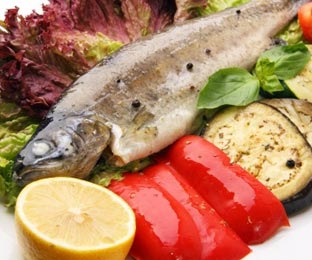Healthy fats in your diet
 Fatty foods are not only considered unhealthy, they also have a reputation for making you fat. Therefore, health-conscious people are mostly concerned to eat as low in fat as possible. Figure-conscious people often even try to banish fat from their diet entirely. However, this is fundamentally wrong, especially since fats are the most important sources of energy available to the human body alongside carbohydrates. Regardless, not all fat is created equal.
Fatty foods are not only considered unhealthy, they also have a reputation for making you fat. Therefore, health-conscious people are mostly concerned to eat as low in fat as possible. Figure-conscious people often even try to banish fat from their diet entirely. However, this is fundamentally wrong, especially since fats are the most important sources of energy available to the human body alongside carbohydrates. Regardless, not all fat is created equal.
Fats are part of a healthy diet!
Fats contained in food consist of so-called fatty acids. These can be divided into saturated and unsaturated acids. In addition, the unsaturated fatty acids can be further subdivided into monounsaturated and polyunsaturated acids. While an excess of saturated fatty acids can actually be harmful to health and therefore, according to the recommendations of the German Nutrition Society (DGE), should account for a maximum of 10 percent of the daily calories consumed, both types of unsaturated fatty acids are extremely healthy. According to the DGE, around 30 percent of the calories consumed throughout the day should consist of fats.
With regard to polyunsaturated fatty acids, it should be pointed out that, contrary to popular opinion, they can lower the potentially threatening LDL cholesterol level, which should not be too high under any circumstances. At the same time, they help to raise the level of rather healthy HDL cholesterol to a normal level. Not least because of this positive effect on the aforementioned HDL cholesterol level, the polyunsaturated fatty acids in particular protect against strokes and mental illnesses such as depression.
The "problem" with polyunsaturated fatty acids, which include omega-3 and omega-6 fatty acids, is that they are essential fats. This means that the body cannot produce these fats itself, unlike saturated fats. It is therefore essential that the requirement for polyunsaturated fatty acids is met through food.
Which foods contain particularly high levels of polyunsaturated fatty acids?
From a nutritional point of view, so-called fatty fish, which should preferably come from the sea, are particularly valuable suppliers of omega-3 fatty acids. Said oily fish are edible fish which, in contrast to the fish species known as white fish, such as haddock or cod, have a particularly high fat content in their muscles. The supplementary intake of such good fats is also in the form of so-called Omega-3 food supplements makes sense.
The best-known types of oily fish include salmon, tuna, mackerel, sprat, herring and sardine, as well as anchovy. It is true that eels and carp are also very fatty. However, since these are native to fresh water, preference should be given to the previously mentioned marine fish. However, if you want to completely do without fish in your diet, you can cover your need for multiply saturated fatty acids purely plant-based with nuts and various vegetable oils.
If there is a greatly increased nutritional requirement, “(fish) meat eaters” as well as vegetarians and vegans should, in case of doubt, resort to appropriate food supplements. The same applies to all those who, for example, want to avoid fatty foods as much as possible as part of a diet. With regard to the last-mentioned point, it should be expressly pointed out that polyunsaturated fatty acids can certainly help to get rid of unwanted pounds. Regardless of this, fats only make you fat if they are consumed in significant excess and / or in conjunction with carbohydrates.
Caution: These foods should only be consumed in moderation!
Since the body produces saturated fatty acids itself to a certain extent, foods with a high content of these fatty acids should only be consumed in moderation. Otherwise, they could become a threat to health and slim lines. These foods primarily include fatty meat and all types of high-fat dairy products such as cheese, cream, cream, quark and yogurt (excluding skimmed milk products, low-fat quark, cottage cheese and other low-fat dairy products). In addition, caution is advised with food and luxury foods that contain animal fats. These "secret suppliers of fat", which usually have a very high sugar content, include chocolate and pastries as well as other sweets.
Warning: These fats should be avoided in any case!
In addition to saturated and unsaturated fatty acids, there are so-called trans fats, which are often referred to as hydrogenated fats. At least in Germany, these fats are subject to labeling for several reasons. As a result, they need to be on the ingredient list of packaged foods, making them relatively easy to find. Industrially produced foods in general and fried foods in particular deserve special attention.
Conclusion
Fats are an essential part of a balanced and therefore particularly healthy diet. However, the proportion of saturated fatty acids, which are mainly found in animal fats, should be very low. The only exception is the meat of the fatty fish native to salt water, which contains a lot of healthy fat. Trans-fats, on the other hand, should be avoided as far as possible, which is why one should always pay attention to "hydrogenated fats" when looking at the list of ingredients for foods.




